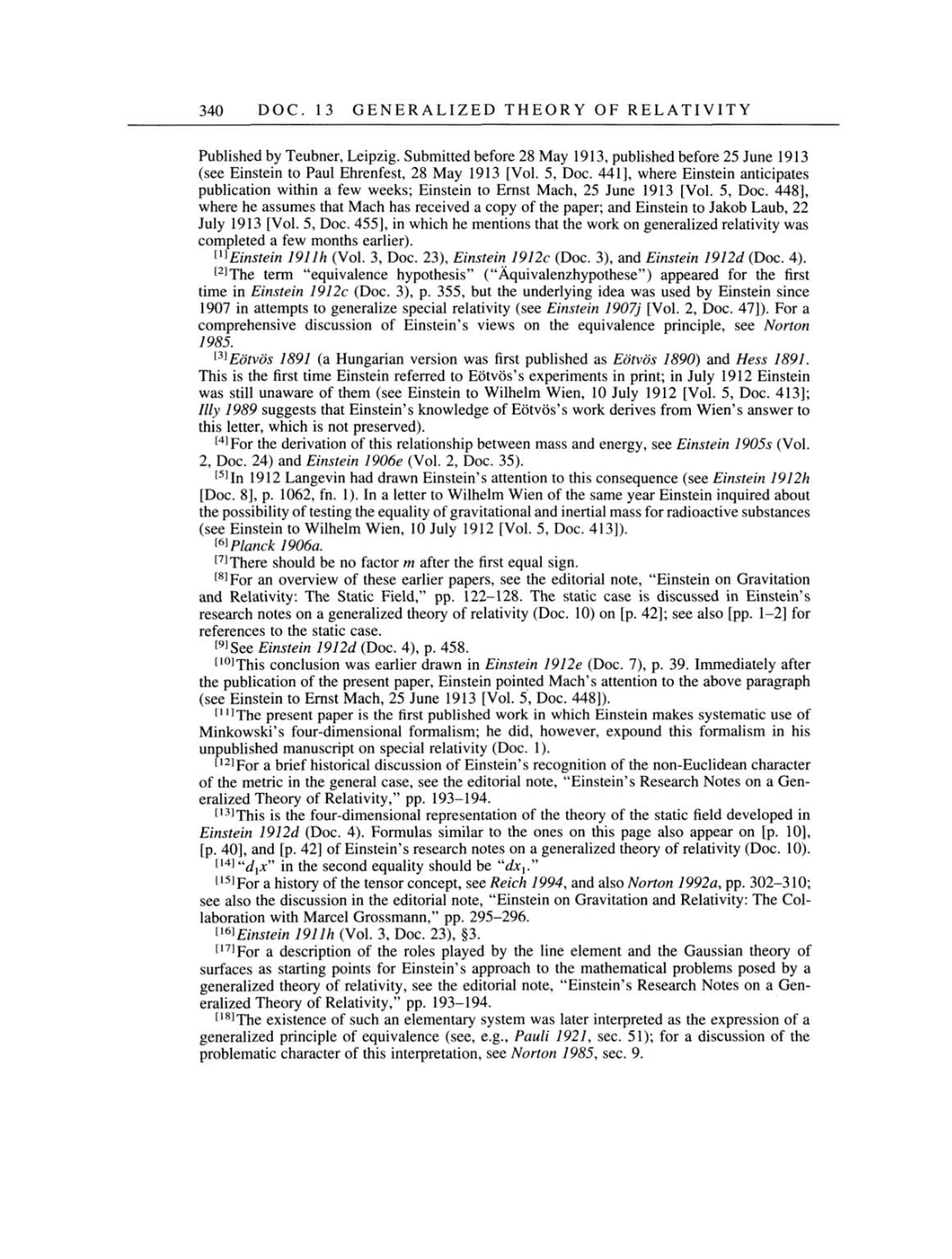340
DOC. 13 GENERALIZED THEORY OF RELATIVITY
Published
by
Teubner,
Leipzig.
Submitted before
28
May 1913, published
before 25
June
1913
(see
Einstein
to Paul Ehrenfest, 28
May
1913
[Vol. 5,
Doc.
441],
where Einstein
anticipates
publication
within
a
few weeks;
Einstein
to
Ernst
Mach, 25
June
1913
[Vol.
5,
Doc.
448],
where he
assumes
that
Mach
has
received
a
copy
of
the
paper;
and
Einstein
to
Jakob
Laub, 22
July
1913
[Vol. 5,
Doc. 455], in
which
he
mentions that the work
on
generalized relativity was
completed a
few
months
earlier).
[1]Einstein
1911h
(Vol.
3,
Doc.
23),
Einstein 1912c
(Doc. 3),
and Einstein 1912d
(Doc. 4).
[2]The term
"equivalence hypothesis" ("Äquivalenzhypothese") appeared
for the
first
time
in
Einstein 1912c
(Doc.
3),
p.
355,
but the
underlying
idea
was
used
by
Einstein
since
1907 in
attempts
to
generalize special relativity
(see
Einstein
1907j
[Vol. 2,
Doc.
47]).
For
a
comprehensive
discussion of Einstein's views
on
the
equivalence principle,
see
Norton
1985.
[3]Eötvös 1891
(a Hungarian
version
was
first
published
as
Eötvös
1890)
and Hess
1891.
This
is
the
first
time Einstein referred
to
Eötvös's
experiments
in
print;
in
July
1912
Einstein
was
still
unaware
of them
(see
Einstein
to
Wilhelm
Wien,
10 July
1912
[Vol. 5,
Doc. 413];
Illy
1989
suggests
that Einstein's
knowledge
of Eötvös's work derives from Wien's
answer
to
this
letter,
which
is not
preserved).
[4]For the
derivation of
this
relationship
between
mass
and
energy,
see
Einstein 1905s
(Vol.
2,
Doc.
24)
and Einstein 1906e
(Vol. 2,
Doc.
35).
[5]In
1912
Langevin
had
drawn Einstein's attention
to
this
consequence
(see
Einstein
1912h
[Doc. 8],
p.
1062,
fn.
1).
In
a
letter
to
Wilhelm Wien of the
same
year
Einstein
inquired
about
the
possibility
of
testing
the
equality
of
gravitational
and
inertial
mass
for radioactive substances
(see
Einstein to
Wilhelm
Wien,
10 July
1912
[Vol. 5,
Doc.
413]).
[6]Planck
1906a.
[7]There should
be
no
factor
m
after the
first
equal
sign.
[8]For
an
overview of these earlier
papers,
see
the editorial
note,
"Einstein
on
Gravitation
and
Relativity:
The Static
Field,"
pp.
122-128. The static
case
is
discussed
in
Einstein's
research
notes
on a
generalized theory
of
relativity
(Doc.
10) on
[p.
42];
see
also
[pp.
1-2]
for
references
to
the
static
case.
[9]See
Einstein 1912d
(Doc. 4),
p.
458.
[10]This
conclusion
was
earlier drawn
in
Einstein 1912e
(Doc. 7),
p.
39.
Immediately
after
the
publication
of
the
present paper,
Einstein
pointed
Mach's attention
to
the above
paragraph
(see
Einstein
to
Ernst
Mach, 25
June
1913
[Vol. 5,
Doc. 448]).
[11]The present paper
is
the
first
published
work
in
which Einstein makes
systematic
use
of
Minkowski's
four-dimensional
formalism; he
did,
however,
expound
this formalism
in
his
unpublished manuscript
on
special relativity (Doc.
1).
[12]For
a
brief historical discussion of Einstein's
recognition
of the non-Euclidean character
of the metric
in the
general case,
see
the editorial note, "Einstein's Research
Notes
on a
Gen-
eralized
Theory
of
Relativity,"
pp.
193-194.
[13]This is the
four-dimensional
representation
of
the
theory
of the static
field
developed
in
Einstein
1912d
(Doc. 4).
Formulas similar
to
the
ones on
this
page
also
appear
on [p.
10],
[p.
40],
and
[p. 42]
of Einstein's research
notes
on a
generalized theory
of
relativity (Doc. 10).
[14]"d1x"
in
the second
equality
should be
"dx1."
[15]For
a
history
of
the tensor
concept, see
Reich
1994, and
also Norton
1992a,
pp.
302-310;
see
also the discussion
in
the editorial
note,
"Einstein
on
Gravitation and
Relativity:
The Col-
laboration
with Marcel
Grossmann,"
pp.
295-296.
[16]Einstein
1911h
(Vol. 3,
Doc.
23), §3.
[17]For
a
description
of the roles
played
by
the
line
element and the Gaussian
theory
of
surfaces
as starting points
for Einstein's
approach
to
the mathematical
problems posed
by a
generalized
theory
of
relativity,
see
the
editorial
note,
"Einstein's Research Notes
on a
Gen-
eralized
Theory
of
Relativity,"
pp.
193-194.
[18]The
existence of such
an
elementary system
was
later
interpreted
as
the
expression
of
a
generalized principle
of
equivalence
(see,
e.g.,
Pauli
1921, sec.
51);
for
a
discussion of the
problematic
character of
this
interpretation,
see
Norton
1985, sec.
9.
